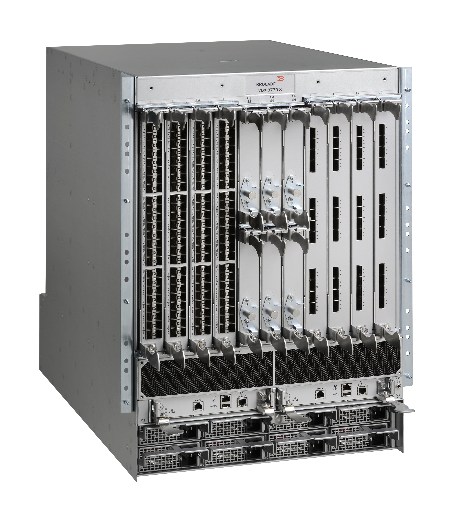The gift of virtualization has always come with a price: Keeping control over the easily created virtual machines and their attached applications running across the network.
At its annual press and analyst briefing day on Wednesday, Brocade Communications Systems Inc. extended its vision of helping IT administrators to create automated network fabrics to handle the load by adding a powerful switch and enhancing its core router platform.
The new VDX 8770 modular core Ethernet switch for large enterprises and service providers, to be released next month, can handle up to 384 10Gigabit Ethernet links or 96 ports of 40GbE.
The top of the VDX line switch, which starts at US$65,000, has a backplane that can handle 4 terrabytes of data per slot backplane so it will be able to handle 100 GbE line cards in the future.

In addition, Brocade said the switch’s customer ASIC processors are built to support next-generation tunnelling protocols.
More importantly, said Jason Nolet, VP of Brocade’s data centre networking group, with the VDX 8770 organizations building data centre fabrics on the company’s VCS design can scale a fabric up to 8,000 switch ports and 384,000 virtual machines attached to the network.
“This now gives us the industry’s broadest portfolio of fabric switches,” Nolet said, that includes the three-member fixed-configuration VDX 6700 series.
Customers can start building a fabric with two top-of-rack switches and go from there, he said.
Brocade is also giving customers of its MLXe core router the option of buying a 24 port 10 GBE module, which would give the ability to have up to 768 10GbE ports on a single chassis.
Finally, the company said a new version 12.5 operating software for its ADX Application Delivery Switches adds multitenancy to the hardware, allowing multiple departments within organizations to use the controller. Or, up to 32 of the units can be consolidated into one.
The announcements impressed industry analysts at the company’s San Jose, Calif., headquarters, where the briefing took place.
Bob Laliberte of the Enterprise Strategy Group, called the VDX 8770 an “impressive piece of technology.” Zeus Kerravala of ZK Research admitted that the market for the switch is limited to large enterprises and service providers, but, he added, that’s historically been Brocade’s target market.
Noting that the company says it has some 700 VDX customers, the 8770 “is a good upgrade for those customers because it allows them to take the scale of that fabric much higher than they can today.”
The briefing could be the last for CEO Michael Klayko, who announced last month that he will step down after heading the company since 2005 after the board selects a new chief executive officer.
Under Klayko’s term, Brocade broadened from a storage networking specialist to include Ethernet network equipment with the 2008 purchase of Foundry Networks. But it still lives in the shadow of Cisco Systems Inc. and Juniper Networks.
To get more growth Brocade needs to get more of the network equipment sold through channel partners, said Kerravala.
“The key now is can they bring in a guy who understands the channel, the difference between system integrators, direct sales? That isn’t an easy thing to do, but if Brocade’s really going to scale from here a channel strategy is going to be the most important part of that. And I don’t know of a person inside Brocade has that experience.”
In addition to products, Brocade executives also talked about its vision for building future data centre Ethernet fabric networks that chop the number of layers down from three to at least two.
Re-architecting and flattening networks isn’t enough, the company said: Networks also have to be automated to enable the smooth flow of virtual machines across the data centre, and, eventually across wide area networks. Some of that capability is now in the VDX line, they said, and more is coming.
In particular, the executives talked about two emerging technologies it wants to leverage, software-defined networks (SDN) and OpenFlow protocol.
CTO Dave Stevens defined SDN as an abstraction layer on top of the physical network that enables the automation to respond to network traffic ebbs and flows, and gives a view across a physical network.
Almost every networking company has an SDN strategy, but as Laliberte noted in an interview, the technology is still in the early stages. SDN approaches and protocols still have to be negotiated through standards bodies, although some vendors are going their own way.